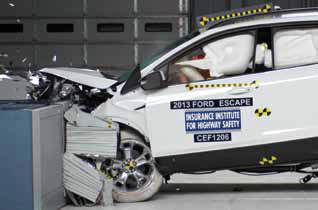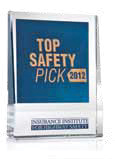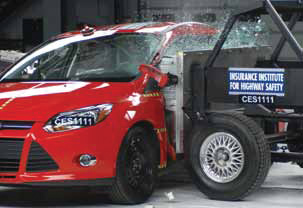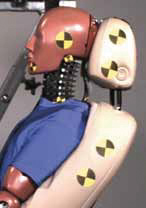SHOPPING FOR A SAFER CAR
![]()

So you’ve decided to buy a car, minivan, SUV or pickup. Now the question is, which one? If you factor safety into your choice you probably want to know: what’s the safest vehicle to buy? Safety has numerous aspects so there’s no direct answer, although it’s clear that some vehicles are safer than others. You can find safer vehicles in various price and style groups. Use this article to help identify the best choices. Start by recognizing that safety involves AVOIDING CRASHES to begin with and then PROTECTING YOU if and when a crash occurs.
CRASH AVOIDANCE
All vehicles have basic features to reduce crash likelihood — lights so other motorists can see you, brakes to stop, etc.
New technology is being added to help avoid crashes in the first place. Two features already are reducing crashes: forward collision avoidance and adaptive headlights. Forward collision avoidance alerts you if you get too close to a car in front and can brake if you don’t respond in time. Other systems brake without warning and are designed for low-speed traffic.
Adaptive headlights shift direction as you steer to help you see better on curves in the dark. Analysis by the Highway Loss Data Institute indicates that forward collision avoidance and adaptive headlights are reducing insurance claims. To find vehicles with these features go to: iihs.org/crash_avoidance.
ELECTRONIC STABILITY CONTROL is a proven crash avoidance feature that’s standard on 2012 and later models. ESC is an extension of antilock brake technology that helps drivers maintain control on curves and slippery roads. ESC engages automatically to help keep the vehicle in the intended line of travel. It lowers the risk of a fatal single vehicle crash by about half and the risk of a fatal rollover by as much as 80 percent. To find earlier models with ESC go to iihs.org/ratings/esc/esc.aspx.
DON’T COUNT ON AVOIDING CRASHES.
Despite everyone’s best efforts, millions of crashes occur each year. Tens of thousands of them involve deaths. So it’s also important to choose a crashworthy vehicle — one that reduces death and injury risk in a crash.
CRASHWORTHINESS
The first crashworthiness attributes to consider are vehicle size and weight. Smaller, lighter vehicles generally offer less protection than larger, heavier ones. There’s less structure to absorb crash energy, so deaths and injuries are more likely to occur in both single and multiple vehicle crashes. If safety is one of your major considerations PASS UP VERY SMALL, LIGHT VEHICLES. This doesn’t mean you have to buy the heaviest vehicle you can find. Above about 4,500 pounds, the injury reduction benefits of more weight are reduced. At the same time, the heaviest vehicles increase the injury risk for people riding in other vehicles with which they collide.
BIGGER GENERALLY IS SAFER
While the risk of death generally is higher in smaller and lighter cars, SUVs and pickups, vehicle size and weight don’t tell the whole story. There are safety differences among vehicles that are similar in size and weight. Some light car models, for example, are safer than others. Some midweight SUVs are safer than others. This is because some models have MORE CRASHWORTHY DESIGNS than others. You can’t tell the difference just by looking. You have to compare crash test results. Most popular models have been tested, so buy one with GOOD CRASHWORTHINESS RATINGS in front, side, rollover and rear crashes.
CHOOSING A CRASHWORTHY DESIGN
Structure and restraints are the main aspects of a vehicle’s design that determine its crashworthiness. Good STRUCTURE means a strong occupant compartment (safety cage), crumple zones to absorb the force of a serious crash, side structures that can manage the force of a striking vehicle or struck object and a strong roof that won’t collapse in on you in a rollover.
Until recently RESTRAINTS included a basic safety belt and frontal airbags. Now there’s more. Crash activated tensioners reduce belt slack. Force limiters can reduce rib injury risk from the belt itself. The inflation characteristics of advanced frontal airbags are geared to specific crash circumstances. Other airbags protect your head and chest in side impacts. Seats and head restraints are being upgraded to reduce neck injuries in rear crashes.
The best way to evaluate a vehicle’s structural design and restraints is in a dynamic test. Based on test performance, a vehicle earns a crashworthiness rating from good to poor.
FRONTAL CRASHWORTHINESS
Crash testing for consumer information began with the federal government’s New Car Assessment Program of 35 mph FRONTAL CRASHES HEAD ON into a rigid barrier. A demanding assessment of vehicle restraints, this test has led to restraint system improvements. The Insurance Institute for Highway Safety also conducts frontal tests for consumer information. A 40 MPH MODERATE OVERLAP TEST complements the government tests, spurring improvements in vehicle structure so that now most passenger vehicles earn good ratings. Look for good ratings in both sets of tests.

THESE WINNERS DO THE BEST JOB OF PROTECTING PEOPLE IN FRONT, SIDE, ROLLOVER AND REAR CRASHES |
 |
2012 WINNERS:
Minicars Fiat 500 built after July 2011
Acura ILX 2013 models
Audi A3
Acura TL built after Sept. 2011 |
Large luxury cars
Chevrolet Equinox
Acura MDX
|
SIDE CRASHWORTHINESS
The government and the Insurance Institute for Highway Safety rate vehicles based on tests that simulate FRONT-INTO-SIDE crashes. In both tests, vehicles are struck by a moving barrier. However, the barriers differ, and the government test doesn’t assess the risk to people’s heads when their vehicles are struck by high riding ones. Look for good ratings in both tests, especially the one that assesses head protection in side impacts, and make sure any vehicle you’re thinking of buying has side airbags that protect people’s heads. Studies of real-world crashes indicate that these substantially reduce fatality risk. If side airbags are optional in a vehicle you’re considering, go ahead and get them. Many side airbags, especially in SUVs and pickups, also are designed to protect you in a rollover.

In the Insurance Institute for Highway Safety’s side crash test, the striking barrier is higher than in the federal government’s test, so it mimics crashes in which occupants’ heads are at risk. Choose a vehicle that earns a good rating in this test.
ROLLOVER CRASHES
When vehicles roll, their roofs hit the ground and crush. Stronger roofs crush less, so the Insurance Institute for Highway Safety rates roof strength to help consumers pick vehicles that are crashworthy in rollovers. To earn a good rating, a roof must withstand a force 4 times the vehicle’s weight before reaching 5 inches of crush. A roof this strong reduces injury risk in a single vehicle rollover by about 50 percent, compared with a roof meeting requirements for 2012 and earlier models.
REAR CRASHWORTHINESS
Compared with front, side and rollover crashes, rear impacts are less likely to threaten your life. Yet rear enders occur frequently and often cause neck injuries to people in struck vehicles. Such injuries can be painful and involve costly, long term consequences. Here’s how the injuries happen: When a vehicle is struck from behind, an occupant suddenly goes forward with the seat. If the head isn’t supported it will lag behind, bending and stretching the neck in a WHIPLASH MOTION. Vehicle seats and head restraints can be designed to reduce whiplash injuries, so the Insurance Institute for Highway Safety first measures restraint geometry (the higher and closer to the back of the head, the better). If head restraint geometry is at least acceptable, then a simulated rear impact of the seat and restraint together completes the evaluation. Look for vehicles that earn good ratings to minimize neck injury risk in rear end crashes, but be careful. You’ll have to pay close attention to the seat options.
A complication is that vehicles are sold with optional seat packages, so one model may include multiple seat designs that earn different ratings. You’ll have to match the seats in a vehicle you want to buy with the specific rating for that seat package. Before you drive away, check to see if the head restraint needs to be adjusted to fit behind your head. If it does, ADJUST IT for good protection.

Good seats/head restraints start with good geometry. The restraints are positioned high and close behind the head.
REMEMBER THE BASICS
Now that you know how to factor safety into your choice of a vehicle to buy, keep this in mind: Vehicle size matters. So do crash avoidance features and especially crashworthiness ratings. You don’t have to forego a stylish vehicle to get one that’s safer. You can have both.
To find and compare safety ratings for hundreds of vehicles, go to iihs.org/ratings AND safercar.gov
iihs.org • iihs.org/rss • youtube.com/iihs • @IIHS_autosafety • m.iihs.org